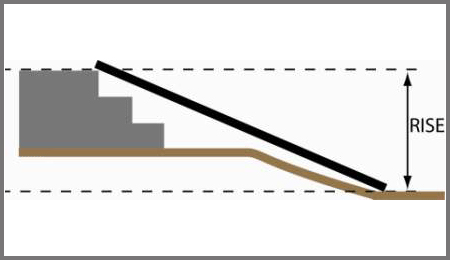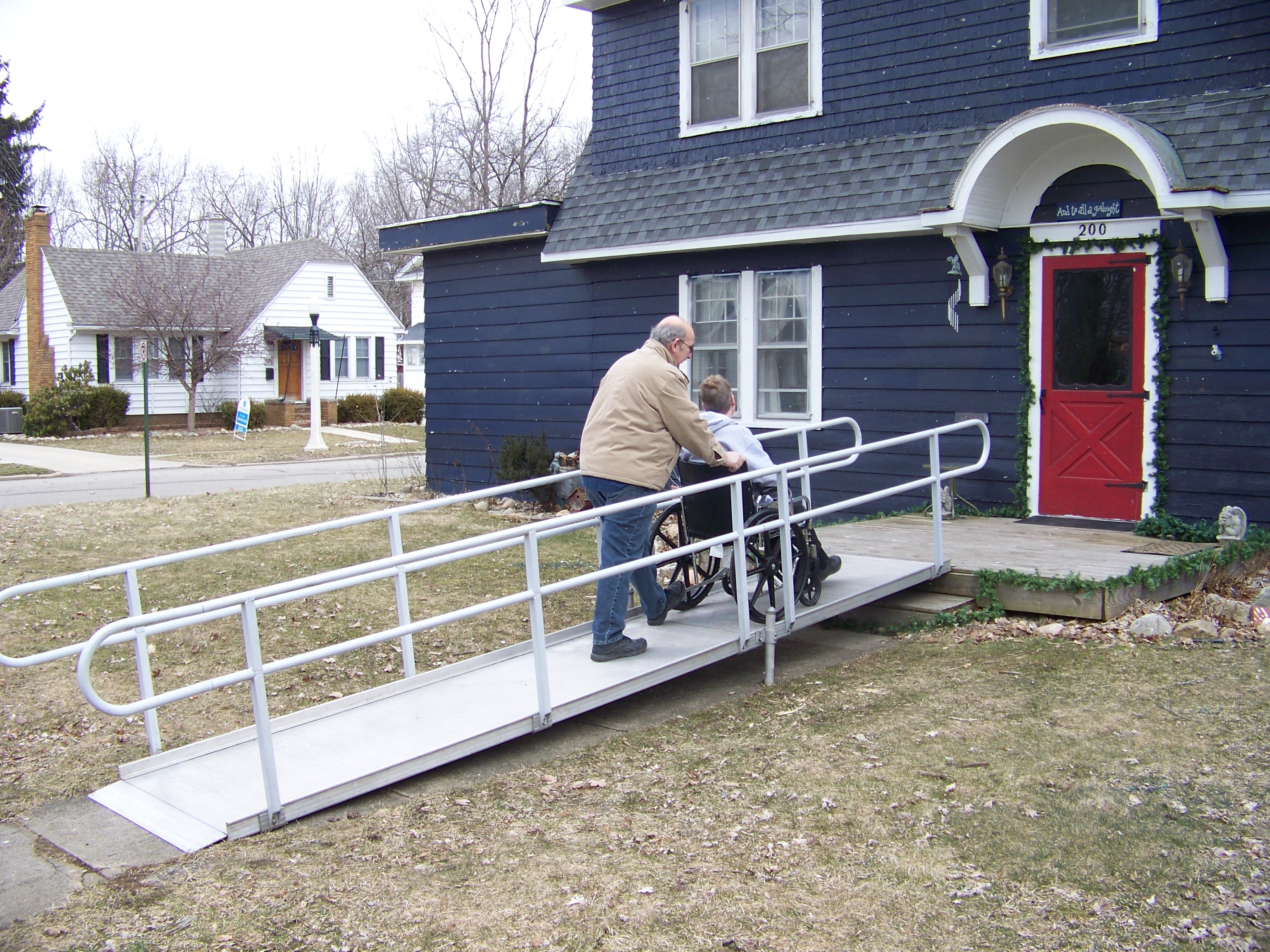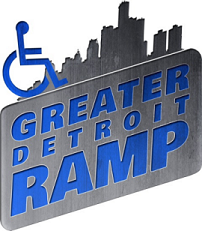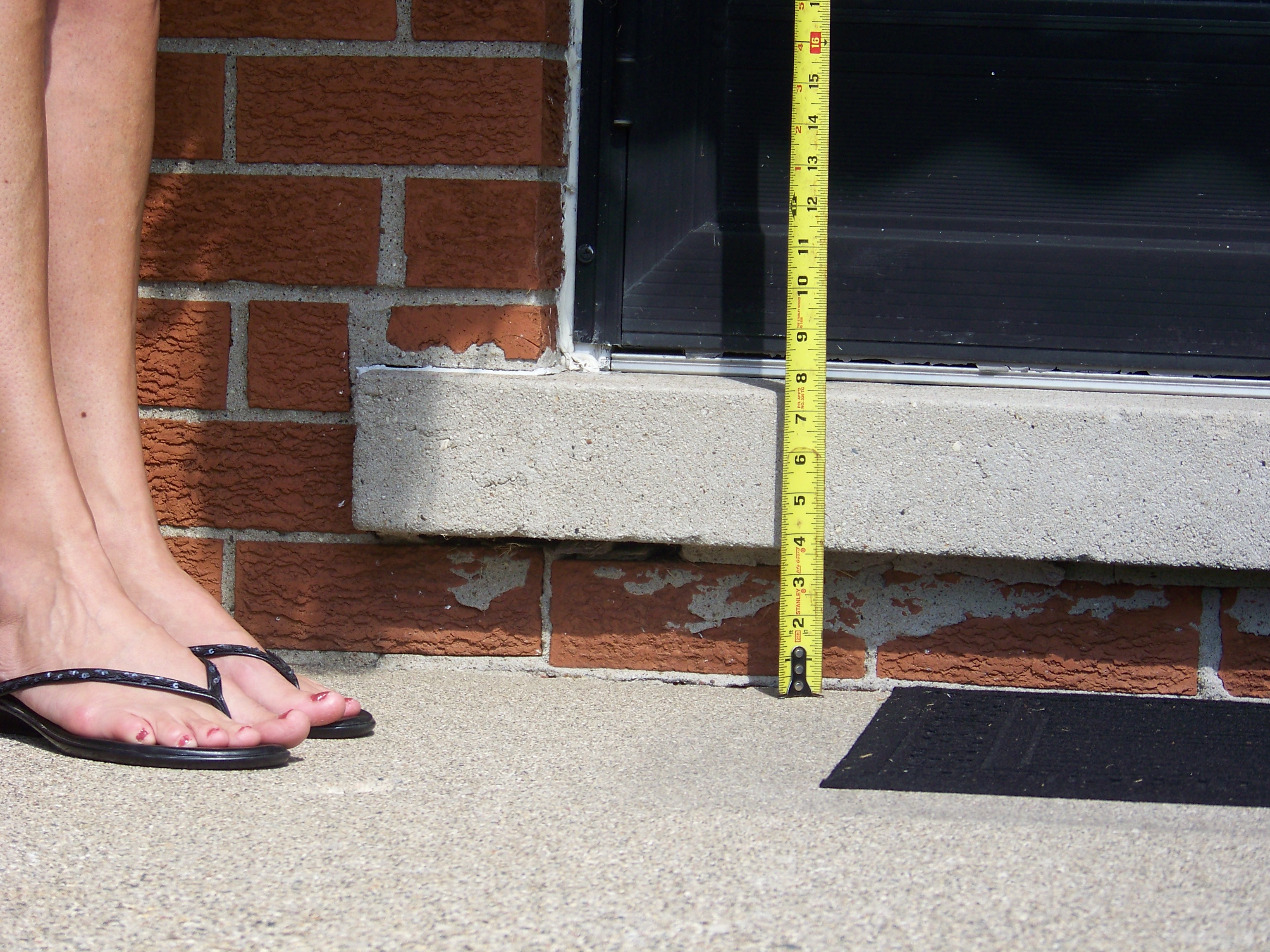Here’s the simple formula: 1:12.
That’s carpenter’s shorthand for 1 inch of “rise” to 12 inches of “run”. In practice, you simply measure the total height that a ramp must “rise” vertically, up from a lower surface to the higher platform. Then, for each inch of vertical rise that you measure, you’ll know that you should “run” the ramp’s length out horizontally 12 inches (one foot) for each inch of rise.
Got it? 1 inch of Rise requires 12 inches (one foot) of Ramp Length, aka “Run”. Simple.

Example in the drawing above: Let’s say we measure up from your concrete front walk, over 3 stairs, up to the surface of your front porch. Typically, that rise will measure about 21 inches or so. (use a yard stick). So if the rise is 21 inches, you know your ramp will need to run at least 21 feet in length to be ADA compliant.
If necessary, factor in ground slope too.

As shown in the above drawing, If the ground around your property slopes down hill away from the house, you’ll also need to add in those extra inches of rise and add another foot of ramp for each additional inch of rise.
“That long? Really?” you ask. Well, as I said above, this is the “simple” formula, so let’s dig deeper.
IT’S AN “ACT OF CONGRESS” (If legal language bores you, scroll down to “COMMON SENSE” below)
If you want to get official, this 1:12 standard was set by Congress in the Americans with Disabilities Act (ADA), updated in the “2010 ADA Standards for Accessible Design. To see this whole enormous document, click here, then scroll about half way down to, “405.2 Slope. Ramp runs shall have a running slope not steeper than 1:12.”
http://www.ada.gov/regs2010/2010ADAStandards/2010ADAstandards.htm
At the state level, Michigan supports these standards in the Michigan Residential Code book under section “R311.8 Ramps”. (Sorry I can’t find an electronic link on line–I guess they want you to buy the entire paper book for $85. All licensed builders like me are sworn to own a hard copy). But the thoughtful City of Wayne, Michigan provides this handy excerpt from the International Construction Code book (ICC) on their own web site, along with comments from their Building Department:
www.ci.wayne.mi.us/pdfs/ramps.pdf
Common Sense
I’ve found that the 1:12 standard is generally manageable for most wheel chair users with average upper body strength, and able bodied care givers. But I’ve also seen that for some, even a 1:12 slope is a challenge. So let’s close the law books for a second and think about the condition of the people who will be using your ramp. The most important considerations when specifying the slope of a ramp are;
- the safety of the “patient” and
- the safety of the “care givers” who will assist them.
 1. THE PATIENT Be realistic about the physical ability of the person who is using an assistive device like a manual wheel chair, cane or a walker to climb up a sloping surface of any pitch. Not to scare you, but seriously think about the consequences of them loosing energy to make it to the top safely. You may decide that the slope of the ramp needs to be even more shallow than the recommended maximum 1:12 slope. Or they may need a platform half way up on which to rest. Now think about the patient’s prognosis in coming months or years. Is their strength and mobility improving, or degrading? If you can take the patient to visit a shopping mall, place of worship, or any other public building, chances are, those buildings have recently been remodeled to include ramps with a 1:12 pitch for equal access as they are required by the ADA. How well does your patient do on those 1:12 public ramps?
1. THE PATIENT Be realistic about the physical ability of the person who is using an assistive device like a manual wheel chair, cane or a walker to climb up a sloping surface of any pitch. Not to scare you, but seriously think about the consequences of them loosing energy to make it to the top safely. You may decide that the slope of the ramp needs to be even more shallow than the recommended maximum 1:12 slope. Or they may need a platform half way up on which to rest. Now think about the patient’s prognosis in coming months or years. Is their strength and mobility improving, or degrading? If you can take the patient to visit a shopping mall, place of worship, or any other public building, chances are, those buildings have recently been remodeled to include ramps with a 1:12 pitch for equal access as they are required by the ADA. How well does your patient do on those 1:12 public ramps?
2. CARE GIVER SAFETY It’s just as important to consider the safety of the people who will assist the patient, pushing them in a manual chair up the ramp. How far can they push an occupied chair before they need a level platform to stop and rest? How heavy is the person they are pushing in the chair? Does the ramp have hand rails for a care giver to grasp, if they need to pause half way up a ramp? Is the care giver physically able to do the job? I know care givers who suffered permanent spine and shoulder injuries from struggling to muscle a patient in a wheel chair up a too-steep, handyman-built ramp. Don’t put both the patient and the care-giver in a risky situation.
Safety First!
Use the published standards as a starting point, but don’t hesitate to provide an even more gentle ramp slope if your common sense tells you to.
How about a steeper ramp?
Reading the documents above, you will see that that 1:12 is the generally accepted, government endorsed standard for maximum ramp slopes in public buildings. But you may have also noticed that the law makers also provided exclusions and exemptions if you read further.
For example if you’re putting a temporary ramp in a building which does not provide enough room for a 1:12 slope, the ADA guidelines allow for a 1:10 slope. And the MI Residential Code allows for a 1:8 slope–but that’s at the discretion of your local building official. A word to the wise: If you’re going to ask your Building Department about installing a ramp steeper than 1:12, be sure to bring a copy of the laws highlighting the exceptions to your meeting. Building Inspectors like to see black letter law if you’re asking them to deviate from the norm.
One national wheel chair ramp manufacturer, Prairie View Industries (PVI) offers this ramp slope calculator to determine the runs at various slopes. Notice that they endorse the use of their ramps by occupied chair users up to a slope of 2:12, but with constant assistance by a caregiver, and in compliance with the local Building Department.
http://www.pviramps.com/products/ramp-length-calculator.php
Manufacturers of power wheel chairs and scooters also have determined their own standards for the slope that their products can climb safely. So if the private user will never use a manual wheel chair, but rides a scooter instead, a ramp steeper than 1:12 may be acceptable for them.
Remember, you must take responsibility for specifying a ramp steeper than 1:12, so consider all of the possibilities so you will never put a chair user or care giver in a dangerous situation.
Are private home owners excluded from the law?
If you read the opening paragraphs of the ADA document, you may have noted that the law makers were thinking about equal employment and equal access to “public” buildings and multi-family housing construction when they wrote the act. The ADA language does not specifically address privately owned, single family homes. So does this mean that private home owners are exempted? Well, not necessarily, because the local Building Departments and the Michigan Residential Code book adopted many of the ADA guidelines, and these codes do apply private homes. But how the codes are enforced is open to some interpretation by your local Building officials.
I’ve often found that placing a simple call to the Building Department clerk, to ask if building permit is required to install a temporary, modular aluminum wheel chair ramp often results in just a few of questions, and a often a verbal approval to proceed without having to apply for a Building Permit. Most Building Departments know that modular aluminum ramps are engineered to be free-standing, with no underground footings, and that they will be removed in the future without permanently altering the house.
But not all cities are the same, so I’ve had to pull Building Permits in almost as many cities as I’ve had them waived. Either way, treat the Building Inspector with professional respect. Remember, they are officers and they carry a badge.
Knowing your Options
The laws set benchmarks for wheel chair ramps slopes, but also provide exclusions. Your local Building Department ultimately enforces the guidelines, so they can choose to make their own exceptions. Manufacturers stand behind the use of their ramps and scooters on various slopes, even greater than the building authorities.
We run this gauntlet quite often to make sure we are compliant with the local authorities. But the most important thing for you to remember is the safety of the two parties mentioned above: 1) the user and 2) the care givers. Don’t skimp on quality, and don’t install a ramp that’s too steep, just to save a few bucks on materials. Keeping a family member safe and living in their own home is far less expensive than transferring them to a rehabilitation hospital or long term assisted living.


